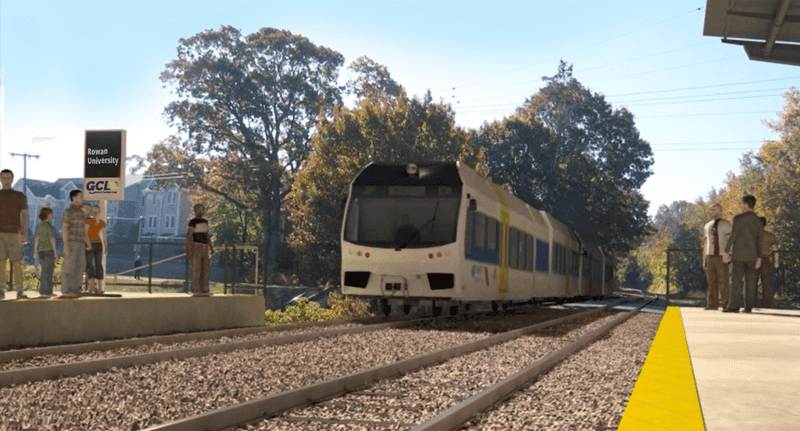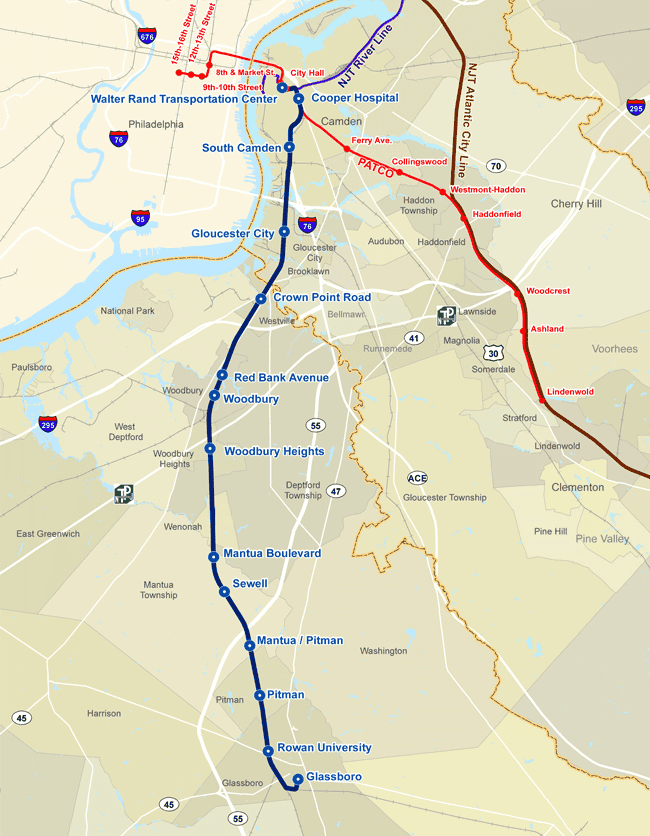

The following is a compilation of articles recently published in the Mantua Sun:
For John Hanson, CEO of the Delaware River Port Authority (DRPA), 2022 means the proposed Glassboro-Camden Line is one year closer to reality.
The still-unfinished line will travel 18 miles from downtown Camden, through Mantua and to Glassboro, and connect with Rowan University’s campus. It is expected to make stops in Pitman, Sewell, Mantua, Wenonah, Woodbury Heights, Woodbury, Westville, Brooklawn and Gloucester City.
“This project, what it is really going to do is effectively extend the Philadelphia-Camden metropolitan region to allow a greater number of people who really aren’t able to participate now to participate,” Hanson explained.
“This project will connect people to jobs and mentors, to schools and teachers, to doctors and medical facilities, to friends and family, to museums and recreational and cultural activities that people can’t really connect to right now,” he added.
The line is promoted as a way for college students to commute to school as well as to work at jobs or internships without the need for a car. And with the area’s growing population, it is a particular benefit.
“Gloucester County is one of the counties in New Jersey that is experiencing the highest rate of residential growth, and with this line, it gives people the opportunity to live in the area without having a vehicle,” said DRPA Principal Engineer Michael Howard.
While the project’s completion is still uncertain, the DRPA is aiming for a ridership of 16,000 people a day by 2040, a number calculated during earlier studies of the line. In Mantua, however, residents have expressed concerns each year as the line gets closer about its affordability and the effect on township taxes.
According to Hanson, property taxes will not be connected to the project since the cost of the line will be paid through tolls and other resources.
“None of the funding for the line is going to come from residents’ property taxes,” he noted. “It’s not going to be a property-tax issue for residents. And this type of transportation is typically funded through the transportation trust fund, which is largely funded by gas taxes.
“It’s not a matter of new taxes being collected, it is a matter of allocation of existing taxes,” Hanson added.
Environment on the line?
Another concern for many residents is the line’s environmental impact: Will the added train cause pollution in the area? Hanson said no, even with the planned train’s diesel engine.
“It’s very clean diesel,” he explained. “If you do the research, there are studies that say clean diesel trains can be cleaner than electric trains, depending upon how the electricity is manufactured.”
As for alternatives that include clean electricity for the line, Hanson noted the technology is not yet there.
“The corridor that we’re going to be using through the Conrail right of way doesn’t allow for a typical electric-type scheme, meaning that overhead catenary or third-rail electric, there’s not enough room out there,” he said.
“If technology becomes available, if a battery-operated or hybrid-type scheme is available, we would use that,” the CEO added. “We will use the cleanest technology available with the least environmental impact, and the diesel that’s currently planned is very clean, with very, very minor environmental impact.”
Because of the DRPA’s effort to make sure the GCL train is the cleanest option, it has received support from local groups focused on environmental activism and sustainability.
“We’ve looked at the Glassboro-Camden rail line’s environmental impact statement to evaluate the project’s influence on geological, hydrological and biological resources, and have come to the conclusion that the GCL’s impact on the communities along the route is minimal compared to the environmental and economic benefits to these towns,” said Sean Mohen, executive director of Tri-County Sustainability.
Tri-County Sustainability (TCS) is Sustainable Jersey’s regional hub for Burlington, Camden and Gloucester counties. It has actively supported the new federal Infrastructure Investment and Jobs Act, which allocates $4.1 billion for public transportation in New Jersey.
According to Mohen, the GCL is the next big step for the region’s investment in mass transit.
“Although not fully electric on day one, the GCL design includes newer diesel technology, with integrated on-board electrical generators, and it’s scalable to incorporate innovation and new battery tech as it becomes available,” he said.
“This is a smart, incremental approach to meeting South Jersey’s mass transit needs,” Mohen added, “and it will go a long way in keeping our recent college grads in our region. GCL is the next generation of travel for the next generation.”

History repeats itself
For the last century, a successful rail service in the area has been a trial-and-error learning experience. According to the Delaware Valley Association of Rail Passengers Director Bill Ritzler, an electric passenger train service between Camden and Millville was implemented in 1909, but while it replaced diesel-powered trains in 1949, the service ended by 1970.
That long-ago transit line is reflected in the GCL proposal. Studies were conducted for a Burlington-Gloucester train line in the early ‘90s, but in 1996, local and regional officials in Gloucester County expressed their opposition to the idea, so NJ Transit system shied away from the county – but not for long.
“There has been a fairly continuous process of study since the early 1990s,” Ritzler revealed. “Despite the redirection of funds to the RiverLine in 1996, passenger rail service in the GCL corridor was again evaluated in the late 1990s, as an alternative to the project that led to the widening of Route 42 to four lanes between Route 55 and I-295.”
As the RiverLine opened services between Camden and Trenton in 2004, the DRPA began to brainstorm the expansion of public transit in Gloucester County. Since then, the agency has rolled out studies to support the line, but not without opposition.
“Since 2009, I’ve heard residents give many reasons for not wanting hundreds of trains and shuttle buses to criss-cross our towns on a daily basis, taxes being the least of their concerns,” Mantua resident Carol Rhodes said. “Greed and incompetence don’t spell success.”
Most recently, Woodbury Heights’ Mayor William Packer and council passed a resolution establishing their opposition to the GCL, a major conflict considering the service would go through that municipality.
“Although the GCL may be intended to positively impact the region as a whole, the borough of Woodbury Heights stands to be negatively impacted by the condemnation of real property and/or the still unknown elements of the planning and construction,” the resolution states.
Given that similar ideas have failed in the past, the question remains: Is the GCL also setting itself up for failure? The future has not been determined, but backlash from local officials and residents is only expected to grow.









